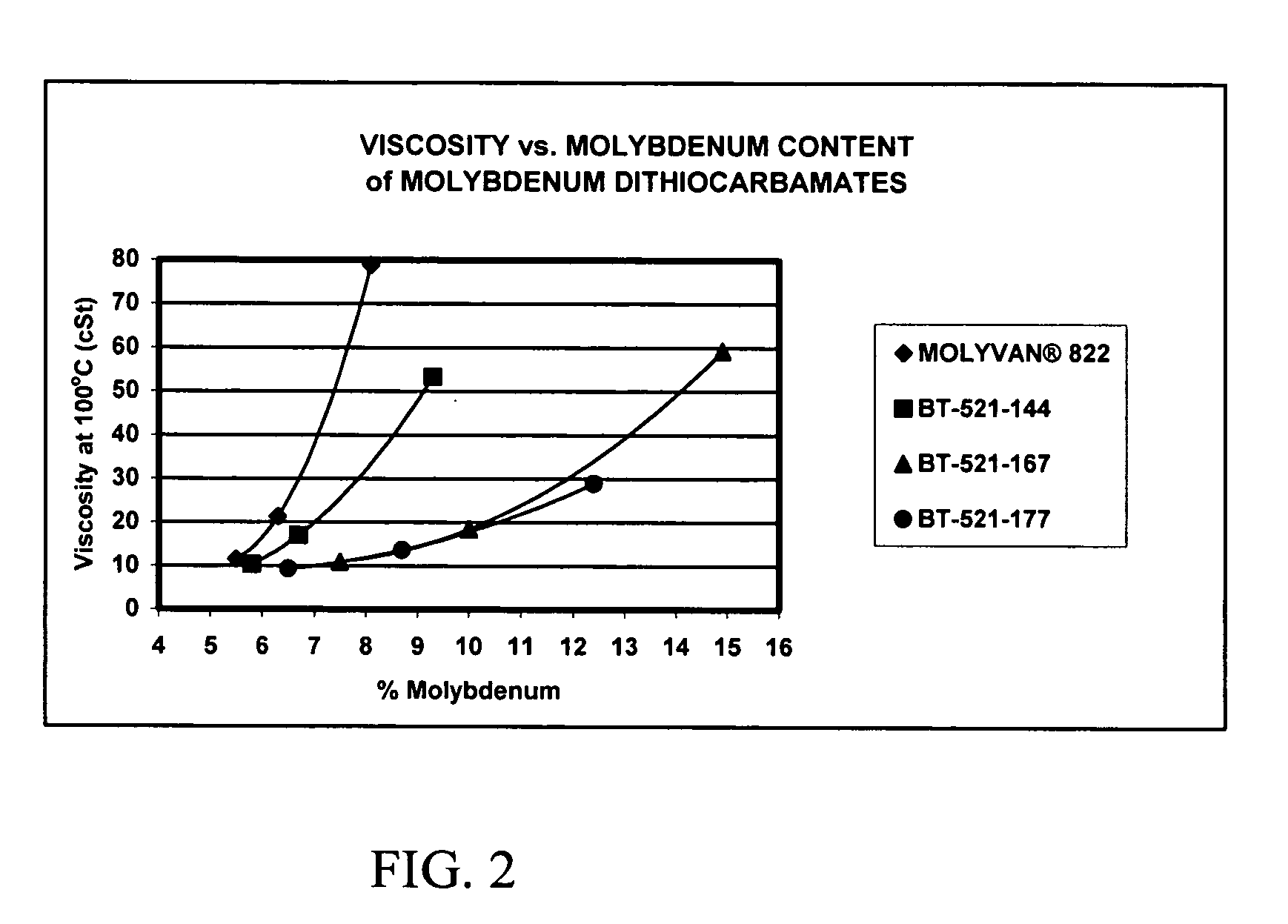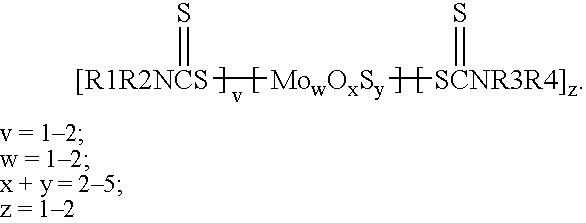Molybdenum dialkyldithiocarbamate compositions and lubricating compositions containing the same
a technology of molybdenum dialkyldithiocarbamate and lubricating composition, which is applied in the field of asymmetric molybdenum dialkyldithiocarbamate, can solve the problems that the invention of compounds and the resulting lubricating compositions cannot be seen in the prior, and the improvement of properties cannot be seen, so as to achieve improved solubility, improved friction reduction properties, and higher molybdenum content
- Summary
- Abstract
- Description
- Claims
- Application Information
AI Technical Summary
Benefits of technology
Problems solved by technology
Method used
Image
Examples
example 1
[0080] Water (23.5 g.), (2-ethylhexyl)tridecylamine (70.7 g., 0.226 mole) and Ergon Hygold oil (8.8 g.) are added to a 500-ml, round-bottom flask. The mixture is cooled to about 20 degrees C. and with good agitation molybdenum trioxide (16.2 g., 0.113 mole) is then added. Using a cooling bath, carbon disulfide (18.0 g., 0.237 mole) is added at such a rate that the reaction temperature does not exceed 45 degrees C. After all the carbon disulfide has been added, the mixture is agitated at 55-60 degrees C. for 30 minutes and then heated to reflux for 4.5 hours. The condenser is then set for distillation and the mixture heated to distill off most of the water. Full vacuum is then slowly applied and the temperature is maintained at 125-130 degrees C. for 2.5-3 hours. The vacuum is released and Ergon Hygold 100 oil (100 g.) is added. The product is then suction filtered at about 80 degrees C. giving a clear, dark-brown liquid (BT-521-144).
example 2
[0081] Water (23.5 g.), isodecyloxypropyl-isopropylamine (available from Tomah3 Products as SA-14,3 ether amine) (55.3 g., ˜0.23 mole) and Uninap 100 SD oil (8.8 g.) are added to a 500-ml, round-bottom flask. The mixture is cooled to about 20 degrees C. and with good agitation molybdenum trioxide (16.2 g., 0.113 mole) is then added. Using a cooling bath, carbon disulfide (18.0 g., 0.237 mole) is added at such a rate that the reaction temperature does not exceed 30 degrees C. After all the carbon disulfide has been added, the mixture is heated to reflux for about 6.5 hours. The condenser is then set for distillation and the mixture heated to distill off most of the water. Full vacuum is slowly applied and the temperature is maintained at 125-130 degrees C. for 30 minutes. The vacuum is released, more Uninap 100 SD oil (41.2 g.) is added and the product is suction filtered while still hot giving a clear, dark red-amber liquid (BT-521-167).
example 3
[0082] Water (23.5 g.), alkyloxypropyl-isopropylamine (alkyl=C12 to C15) (available from Tomah3 Products as SA-19,3 ether amine) (80.0 g., 0.23 mole) and Uninap 100 SD oil (8.8 g.) are added to a 500-ml, round-bottom flask. The mixture is cooled to about 25 degrees C. and with good agitation molybdenum trioxide (16.2 g., 0.113 mole) is then added. Using a cooling bath, carbon disulfide (18.0 g., 0.237 mole) is added at such a rate that the reaction temperature does not exceed 40 degrees C. After all the carbon disulfide has been added, the mixture is heated to reflux for about 3.5 hours. The condenser is then set for distillation and the mixture heated to distill off most of the water. Full vacuum is slowly applied and the temperature is maintained at 125-130 degrees C. for 30 minutes. The vacuum is released and the product is suction filtered while still hot giving a clear, dark red-amber liquid (BT-521-177).
PUM
| Property | Measurement | Unit |
|---|---|---|
| weight percent | aaaaa | aaaaa |
| weight percent | aaaaa | aaaaa |
| weight | aaaaa | aaaaa |
Abstract
Description
Claims
Application Information
 Login to View More
Login to View More - R&D
- Intellectual Property
- Life Sciences
- Materials
- Tech Scout
- Unparalleled Data Quality
- Higher Quality Content
- 60% Fewer Hallucinations
Browse by: Latest US Patents, China's latest patents, Technical Efficacy Thesaurus, Application Domain, Technology Topic, Popular Technical Reports.
© 2025 PatSnap. All rights reserved.Legal|Privacy policy|Modern Slavery Act Transparency Statement|Sitemap|About US| Contact US: help@patsnap.com



